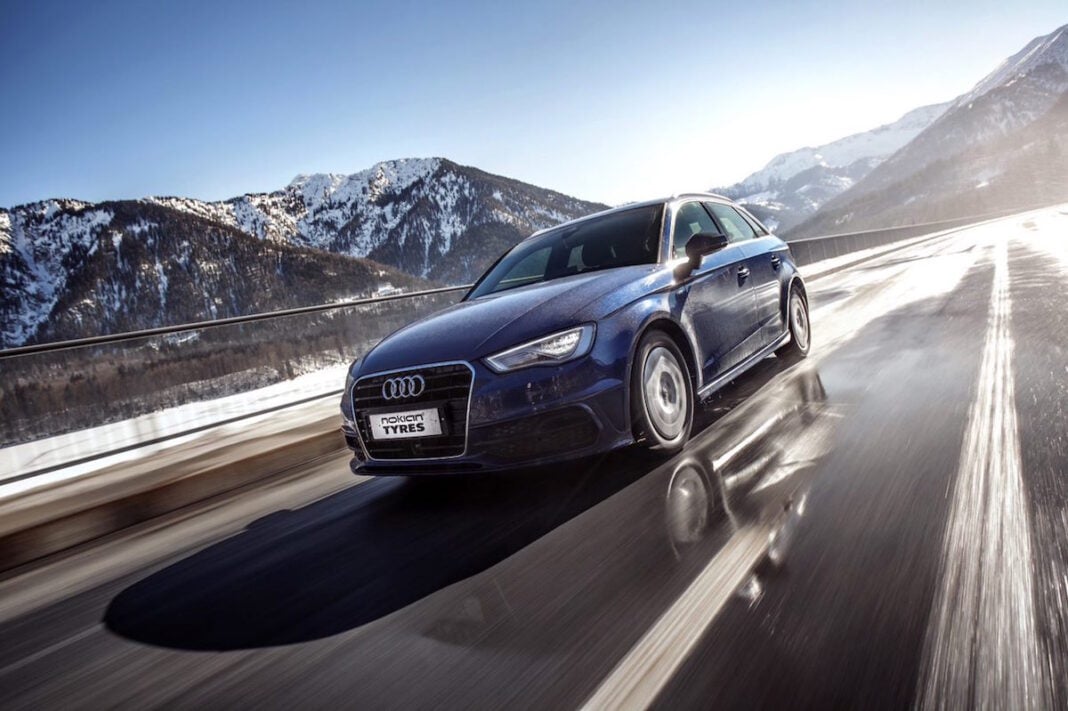Sponsored by

Winter tires are a crucial safety technology when driving in cold weather but can represent a sizeable investment. The logistics of switching to a second set of wheels can also be a pain, especially if you live in an apartment or other property with limited storage space.
It can, therefore, be just as tempting to stick with a set of winter tires year-round as it is to keep all-season tires on the car permanently. Unfortunately, running winter tires through the warm summer months – just like remaining on all seasons in wintertime – comes with some critical safety concerns.
Four reasons to avoid riding on snow tires during warmer seasons
1. Winter tires are built for the cold, not the heat
It all starts with how winter tires are designed. The rubber compounds used are formulated to remain flexible at cold temperatures, typically, below 7°C or 45°F. In scientific terms, the glass transition temperature – the point at which the rubber becomes hard and brittle – has been lowered so that the tire retains grip in extremely cold weather. In the hot summer months, the further the tire gets from that glass transition temperature, the more flexible it becomes.
2. Expect them to wear out faster in summer
One of the most significant impacts of this is on tire wear. Winter tires will wear out faster in warmer temperatures. Drivers also notice that as the rubber becomes more flexible, the vehicle’s handling deteriorates. Winter tires are commonly associated with slightly decreased handling properties due to the softer rubber and more open tread construction. But that effect is compounded as the ambient temperature rises.
“The mushy feeling that you might see from some winter tires becomes much worse as temperatures increase,” confirms Steve Bourassa, Nokian Tyres’ director of products for North America. “It can reach the point where the vehicle’s responsiveness is impacted to such a level that safety is compromised.
3. Reduction in wet grip
“But when it comes to safety, the biggest reason you wouldn’t want to run winter tires in the summertime is a reduction in the available wet grip. When building a winter tire, you choose to increase grip on snow and ice, which oftentimes means decreasing the wet grip. It means that wet grip on asphalt can certainly be compromised in the summer months.”
In short, the vehicle will not stop as quickly as it should on wet roads.
In short, the vehicle will not stop as quickly as it should on wet roads. Nokian cites figures from a comparison test in Sweden. It showed how, when stopping from 50mph (80km/h) on a wet road surface, a worn-out, non-studded winter tire required around 40ft (12m) more to come to a stop than an all-season tire in good condition.
That’s more than two car lengths. Drivers fit winter tires to shorten the braking distance in winter, but in summer, it has the opposite effect.
4. Higher chance of hydroplaning

It’s a similar picture when it comes to hydroplaning – the condition where the tire tread cannot evacuate the water fast enough, and the tire rides up on a layer of water above the road surface. An all-season tire might reach 50mph (80km/h) or more on a wet road before hydroplaning, whereas the worn winter tire skids out of control at 23mph (37km/h).
All-weather tires are a great alternative

A recent trend in the tire market is the introduction of all-weather tires like the Nokian WRG4. The difference between all-weather and all-season can confuse some buyers, especially because some all-weathers are closer to all-seasons, but others are more like full winter tires.
One crucial differentiator between all-seasons and all-weathers is often the inclusion of the 3-Peak Mountain Snowflake (3PMSF) symbol, which means the tire is certified for winter use.

All-weather tires vs. snow tires
“Winter tires are soft and flexible, with lots of dense siping (cuts in the tread pattern),” explains Bourassa. “Oftentimes, that siping cuts all the way through the tread blocks, improving the grip abilities.
At the other end of the scale, an all-season tire like the new Nokian One is harder and focuses on longevity and wet grip. Some of the sipes are closed at one end or both ends, helping to improve the stability of the tire. An all-weather tire meets the two in the middle with a mixture of more stable blocks and open siping and a compound that sits between winter and all-season.”
He adds that all-weather tires can be a good year-round choice in areas that receive some winter weather but not in places that get extreme heat in summer or extreme cold in winter, where there’s no substitute for fitting the most appropriate tire for the conditions. He doesn’t recommend European-style full summer tires for use in North America, either, except on performance vehicles, where their high wear characteristics are less of a concern.
Finally, whichever tire you fit to your vehicle, sufficient tread depth is always important for it to perform at its best. Nokian recommends that the tread should not wear down to below 4/32in (3mm) before being replaced.


